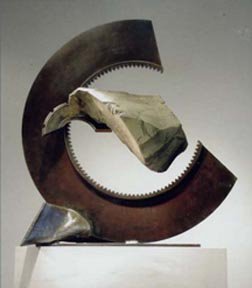Indo-U.S. Startup

Last Thursday, Gloria Starr Kins and John D. McCahill Co-Chaired a Diplomatic Reception for The New Jersey World Trade Council at the Indian Consulate. Virginia Bauer, New Jersey's Secretary of Commerce, spoke about John Corzine's financial industry background helping to enhance the business climate in New Jersey........
link to the website of The Consulate General of India
Ms. Neelam Deo, the new Consul General of India in New York, gave a brief speech, noting that India welcomes foreign investments now. The mood was one of muted caution and temperance, in view of the unpredictable outcome of next week's state visit, but inevitably, even at a low key, the gathering became convivial.
For those of us who've spent our lives on the cusp, absorbing soundbytes about the two democracies since childhood, the near possibility of an enhanced relationship between the two countries opens up a familiar fantasy with a colorful prospect, including a feast of cross-cultural possibilities for a content-hungry world, not to mention a separate feast at the table of intellectual property rights, and visions of jatra performances here and Pilobolus there, and so on....
Urban India sure has become shiny-shiny, but intellectual and politcal India is currently bristling from the Left, Right, Left, Right and Center at any hint of patronage from the Bush Administration, in whatever way it variously applies. Here, the mainstream press has concentrated on America's future ability to control nuclear proliferation on the Subcontinent, but the press here is not as yet looking at what I was looking for a few weeks ago, which is that The Durand Line has become a real, operative, confounding issue. (all these links are for friends who don't read the papers from both countries.) It would be unfortunate indeed if a Masterpiece Theater view of India among the Bush entourage holds sway over current fission-fusion negotiations. Some sources say all Islamic monuments are off limits for the India tour of GWB; others say Purana Qila is all good, identifying with the Pandavas and not Sher Shah's renovations,
 I suppose, although why that is supposed to be correct and necessary is anybody's guess. I just hope that arranging for him to address a giant gathering (okay, not multitudes) from a spot right next to The National Zoo inside Purana Qila doesn't incite some other kind of pandemonium.
I suppose, although why that is supposed to be correct and necessary is anybody's guess. I just hope that arranging for him to address a giant gathering (okay, not multitudes) from a spot right next to The National Zoo inside Purana Qila doesn't incite some other kind of pandemonium.picture of Purana Qila from geocities.com
No point in AISers and all other cuspy types growing old waiting
 with bated breath for all the right things to happen, though. The time to party is now!
with bated breath for all the right things to happen, though. The time to party is now! Maura Moynihan says the K2 Lounge at the Rubin Museum is the place to be on Fridays - for desis and videsis - and I'm adding for pardesis and swadeshis also. The
 newest museum in the City is a luminous grandchild of the FLW Guggenheim, and houses a magnifient collection of Himalayan art from every period. There are dieties and demons, mendicants and meditators, tankhas and mandalas, tantric siddhas and perfected beings from all over the vastness of the Himalayas. Next Friday is Tibetan Independence Day - there will be momos and more. 17th Street and Seventh Avenue, where Barney's used to be. More on this later.....
newest museum in the City is a luminous grandchild of the FLW Guggenheim, and houses a magnifient collection of Himalayan art from every period. There are dieties and demons, mendicants and meditators, tankhas and mandalas, tantric siddhas and perfected beings from all over the vastness of the Himalayas. Next Friday is Tibetan Independence Day - there will be momos and more. 17th Street and Seventh Avenue, where Barney's used to be. More on this later.....



















